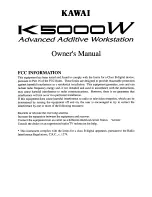
Scope / Multimeter
Operation and Controls
21
For probe calibration information, see
.
Channel Settings
The majority of the channel (trace) settings and controls are located in the Control
Panel. Each setting is represented by an icon, or a value. Icons are used to make
adjustments, and the displayed values represent an individual characteristic.
Depending on the test, applicable settings are displayed. The following image
shows different views of the control panels to identify the different controls.
Figure 3-20
Probe “test” Options
Menu Option
Probe / Device Used
Test Lead - Volts DC
Standard Channel 1 and 2 test leads with alligator clips
or test probes
Vacuum 100
(optional) 0-100 psi pressure transducer with pressure
adapter
Pressure 100
Pressure 500
(optional) 0-500 psi pressure transducer with pressure
adapter
Pressure 5000
(optional) 0-5000 psi pressure transducer with pressure
adapter
Low Amps 20
(optional) Low Amp Probe
Low Amps 40
Low Amps 60
Ignition
(optional) Secondary ignition adapter lead with desired
secondary ignition coil adapter
EEDM506D Temperature
(optional) Part number - EEDM506D temperature
adapter
MT5030 Vacuum
(optional) Part number - EEDM5030 0-500 pressure
adapter
MT5030 Pressure
1—
Show/Hide (Channel display on/off)
—
turns channel on/off
2—
Trace (Zero Baseline position
adjustment)
—adjusts zero baseline
position
3—
Probe (Probe type “test” selection)
changes test probe function
4—
—maximizes sampling rate
5—
—removes signal noise or
interference
6—
—switches signal polarity
7—
—blocks the DC portion of
signal
8—
Scale (Vertical scale adjustment)
adjusts vertical scale
9—
—turns triggering on/off, and sets
direction of trigger slope
10—
—clears Min, Max and Live
values and resets to zero
11—
Min, Live and Max Display Panel
displays lowest, highest and current
trace measurements set since the test
was activated
12—
Sweep (Horizontal or Time scale
adjustment)
—adjusts horizontal scale
13—
Trigger Position Icon
—opens trigger
position control panel
14—
provide a more accurate measurement
on select tests where noise is present
(GMM only)
15—
—used to measure time,
amplitude and frequency
16—
—displays
signal amplitude at cursor and cursor
position in time
















































